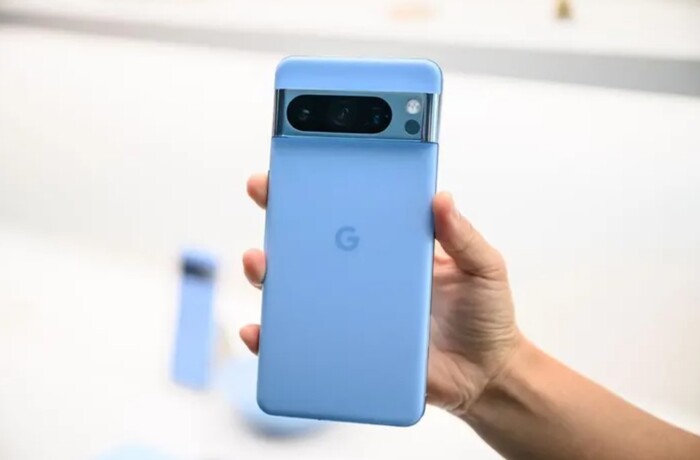Enlarge image
Pixel 6 Pro (above) and Pixel 6: aggressive handling of the camera hump
Photo: Matthias Kremp / DER SPIEGEL
Google designers dare to do something, there is no other way of saying it.
While users keep getting excited about the large camera bobbins on the back of current smartphones, they add one more thing: The back of the new Google smartphones, which the company presented on Tuesday evening, is dominated by a camera structure that is downright outrageous across the entire width of the device.
It's not subtle, but unique and therefore an eye-catcher.
Just as Apple's AirPods were once unmistakable with their white plastic look, in the future you will recognize at first glance when someone is wearing one of the new Google devices, called the Pixel 6 and Pixel 6 Pro.
Apparently that is important to Google.
For years, the company with its smartphones lagged far behind companies like Samsung and Huawei under "also ran around".
But already in August, Google manager Rick Osterloh told SPIEGEL that the two models now being presented would help the cell phone division achieve “significant growth”.
They should bring the company back into the "flagship segment", in which Google, according to Osterloh, was "not really" represented so far.
The most important ingredient for this is the Tensor Processing Unit (TPU), the first smartphone chip that Google developed itself.
The company has, so to speak, tailor-made this processor and, above all, has optimized those functions that are important for Google's software: artificial intelligence (AI) and machine learning (ML).
Tests have to show what this brings in practice, but what Google promises sounds tempting.
The various options for translating between languages in real time, for example.
For example, the devices should be able to translate text from foreign languages into that of the user on photos.
In an "interpreter mode", the Google Assistant should be able to translate spoken language simultaneously, and the devices should also be able to interpret from one language into another without delay in text chats.
You have never been closer to the Babelfish from Douglas Adams' "The Hitchhiker's Guide to the Galaxy".
Offline, i.e. on the device itself, all of this only works in a few languages for the time being, including German, English and Japanese.
The "do-the-photo-bomber-away" effect
Another application of artificial intelligence and machine learning, the “magic eraser”, is likely to be used even more frequently.
This is how Google describes a function in the Photos app that is supposed to automatically remove annoying elements from photos, a job that until recently required you to be a Photoshop professional.
Here, however, the app itself should make suggestions as to what would be worth removing, such as the annoying photo bomber in the background.
If the suggestions do not match, you should be able to mark the desired object with your finger so that it is deleted from the picture.
Here, too, it is important to check whether Google's AI Photoshopper is really as good as the company promises.
Particularly "authentic" recordings
In any case, there are indications that it will be worthwhile to try out the cameras of the Pixel 6 and 6 Pro.
Both have a 50-megapixel wide-angle camera and a 12-megapixel ultra-wide-angle camera.
The Pro model also has a telephoto camera with 48 megapixels, which offers a four-fold optical and up to 20-fold digital zoom.
The front cameras have 8 (Pixel 6) and 11.1 megapixels (Pixel 6 Pro).
As a special feature, Google advertises two new recording modes.
Interesting lighting effects are to be recorded using long-term exposures and dynamic effects, for example of rotating wheels, are to be recorded in the »Action photo with panning effect« mode.
Above all, however, Google describes the cameras in the new pixel cell phones as particularly "authentic" because they are supposed to reproduce the different skin tones of people in a particularly realistic manner.
Charge wirelessly and quickly
The new upper-class claim fits that both Pixel 6 variants can be charged wirelessly by chargers that meet the Qi standard.
If you charge it by cable, the battery should be half full within 30 minutes using a 30 watt charger.
You have to bring the appropriate charger with you or buy it as an accessory; Google only puts the charging cable in the box.
While the features of the two new Google phones are otherwise largely identical, apart from the telecamera, there are subtle differences in the screens.
The 6.4-inch display of the Pixel 6 has a maximum refresh rate of 90 Hertz, while the 6.7-inch display of the Pixel 6 Pro shows up to 120 images per second.
more on the subject
New function: you will soon be able to control Android cell phones with facial expressionsBy Matthias Kremp
New Google smartphones: "We have developed a mobile AI computer" An interview by Helene Laube, Mountain View
Fairphone 4 in the test: A cell phone also for the next-but-one AndroidBy Matthias Kremp
Google Developer Conference: This is new for Android 12 by Matthias Kremp
In addition, the storage space of the Pixel 6 is limited to 128 gigabytes (GB), the Pixel 6 Pro is optionally available with 128 or 256 GB storage space.
It is not expandable in either case.
In view of the demand for devices to penetrate the upper class, the prices are moderate: Google charges 649 euros for the Pixel 6, and 899 or 999 euros for the Pixel 6 Pro, depending on the memory configuration.
The competition is now mostly in the four-digit range.
Both will be delivered with the new Android 12. The two new Pixel Phones will be supplied with future Android versions for three years, and Google promises to deliver security updates for five years.
Both should be available from October 28th.










